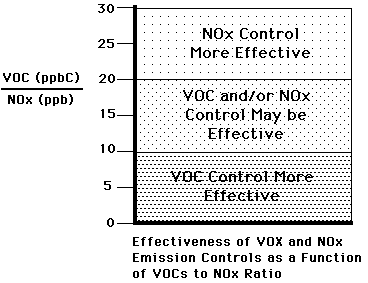Implementing EKMA: Step 2
Two critical concepts/terms are introduced in this reading:
- daily ozone design value: this value is the maximum one-hour average ozone concentration (in units of ppm) measured at the modeling site. The whole purpose of the modeling approach is to reduce this design value concentration down to a target, typically 0.12 ppm, by reducing emissions generations.
For purposes of this scenario, the daily design value will be determined by taking the average of the monitoring data provided on the Useful Datasets page. For each monitoring site (urban, downwind, and upwind), the appropriate maximum ozone concentration should be selected, following the guidelines in Step 1 of the readings.
- design ratio: this is the ratio of VOCs to NOx. This value is used on the isopleth diagram to draw a diagonal line across the diagram, relating amounts of VOCs and NOx to the ozone isopleths. There are numerous studies that address the appropriate choice of this data point.
As a general overview, the significance of this ratio is as follows: depending on its value, the modeler can make some intelligent guesses as to which precursors -- VOCs, NOx, or both -- might provide the best chance of reducing the maximum hourly average ozone concentration for a given location. The graphic below shows this significance.

Typical values for VOCs/NOx are in the range of 6.4-10.5:1. In this scenario, the senior management of AQS has requested guidance from the EPA on the choice of a design ratio. The EPA has responded back with a memorandum concerning this issue.
From an air quality perspective, the design ratio is usually defined as "a characteristic of a city which would prevail during the remainder of the morning and early afternoon in the absence of chemical reactions". Design ratios are calculated based on the average of hourly concentrations beginning at 0600 (6 am) through 0900 (9 am) at the modeling site.
The choice of the design ratio has significant implications for the results produced by the modeling approach and the model. The effect of the modeling approach clearly depends on the particular VOC/NOx design ratio chosen. The design ratio is often specific to a given geographical region.
The isopleth diagram generated in the EKMA/OZIP model confirms an idea that is somewhat counter-intuitive -- that under some conditions, the reduction of a primary pollutant such as VOCs or NOx actually causes an increase in the concentration of a secondary pollutant such as ozone. For example, in the reaction:
NO + O3 ----> NO2 + O2
we see that there is actually a decrease in the amount of ozone in the atmosphere with an increase in NO! At high NOx concentrations, as ozone forms it with react with the NO present, and serves to inhibit the increase in ozone concentraion. Likewise, high NOx concentrations can serve as terminators of chain reactions involving free radicals such as the hydroxyl (OH) radical:
NO2 + OH + M ----> HNO3 + M
There is considerable controversy concerning this finding, and has led to studies and recommendations that NOx controls do not represent a significant tool for the reduction of tropospheric ozone. The nonlinearity of the isopleths generated using this approach strongly suggest that a control strategy that simply looks at a reduction of both precursors may not be the optimal control strategy to be implemented by a particular community.
Back to Implementing EKMA




Developed by
 The Shodor
Education Foundation, Inc.
The Shodor
Education Foundation, Inc.
Copyright © 1997

 The Shodor
Education Foundation, Inc.
The Shodor
Education Foundation, Inc.